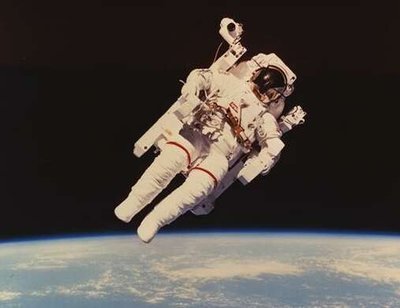Manned Maneuvering Unit
|
|
A Manned Maneuvering Unit (MMU) is a jetpack (propulsion backpack that snaps onto the back of the spacesuit) which has been used on spacewalks (EVAs) from NASA's space shuttle, allowing an astronaut to move independently from the shuttle.
The unit featured redundancy to protect against failure of individual systems. It was designed to fit over the life-support system backpack of the Space Shuttle Extravehicular Mobility Unit (EMU). When carried into space, the MMU was stowed in a support station attached to the wall of the payload bay near the airlock hatch. Two MMUs were carried on a mission, with the second unit mounted across from the first on the opposite payload bay wall. The MMU controller arms were folded for storage. When an astronaut backed into the unit and snapped the life-support system into place, the arms were unfolded.
To adapt to astronauts with different arm lengths, controller arms could be adjusted over a range of approximately 13 centimetres. The MMU was small enough to be maneuvered with ease around and within complex structures. With a full propellant load, its mass was 148 kilograms (326 pounds).
Gaseous nitrogen was used as the propellant for the MMU. Two aluminium tanks with Kevlar wrappings contained 5.9 kilograms of nitrogen each, enough propellant for a six-hour EVA depending on the amount of maneuvering done.
There were 24 nozzle thrusters placed at different locations on the MMU. To operate the propulsion system, the astronaut used his or her fingertips to manipulate hand controllers at the ends of the MMU's two arms. The right controller produced rotational acceleration for roll, pitch, and yaw. The left controller produced acceleration without rotation for moving forward-back, up-down, and left-right. Coordination of the two controllers produced intricate movements in the unit. Once a desired orientation was achieved, the astronaut could engage an automatic attitude-hold function that maintained the inertial attitude of the unit in flight. This freed both hands for work.
The MMU was used on three Shuttle missions in 1984. It was first tested on February 7 during mission STS-41-B by astronauts Bruce McCandless and Robert L. Stewart. Two months later during mission STS-41-C, astronauts James van Hoften and George Nelson used the MMU to capture the Solar Maximum mission satellite and to bring it into the orbiter's payload bay for repairs and servicing. Their work increased the lifespan of the satellite.
The final MMU mission was STS-51-A, which flew in November of 1984. The propulsion unit was used to retrieve two communication satellites, Westar VI and Palapa-B2, that did not reach their proper orbits because of faulty propulsion modules. Astronauts Joseph Allen and Dale Gardner captured the two satellites and brought them into the Orbiter payload bay for stowage and return to Earth.
The Simplified Aid for EVA Rescue (SAFER) was a smaller backpack propulsion system intended as a safety device during space walks. Other Crew Self Rescue (CSR) devices of which prototypes have been developed include an inflatable pole, a telescoping pole, a bi-stem pole and a bola-type lasso device (astrorope) the drifting astronaut could throw to hook to the space station.
A gas gun has also been used in space on EVAs for moving around, e.g. the Hand-Held Maneuvering Unit (HHMU), using compressed oxygen, and, for testing as CSR, the Crew Propulsive Device (CPD), using compressed nitrogen.
External links
- "More Favored than the Birds": The Manned Maneuvering Unit in Space (http://history.nasa.gov/SP-4219/Chapter13.html)
- NASA Manned maneuvering unit: User's guide - 1978 (PDF document) (http://ntrs.nasa.gov/archive/nasa/casi.ntrs.nasa.gov/19790008382_1979008382.pdf)
- Assessment of the NASA Manned Maneuvering Unit - 1988 (PDF document) (http://ntrs.nasa.gov/archive/nasa/casi.ntrs.nasa.gov/19900001658_1990001658.pdf)

